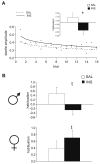Moderate recurrent hypoglycemia during early development leads to persistent changes in affective behavior in the rat
- PMID: 19944751
- PMCID: PMC2885529
- DOI: 10.1016/j.bbi.2009.11.013
Moderate recurrent hypoglycemia during early development leads to persistent changes in affective behavior in the rat
Abstract
Recurrent hypoglycemia is a common problem among infants and children that is associated with several metabolic disorders and insulin-dependent diabetes mellitus. Although studies have reported a relationship between a history of juvenile hypoglycemia and psychological health problems, the direct effects of recurrent moderate hypoglycemia have not been fully determined. Thus, in this study, we used an animal model to examine the effects of recurrent hypoglycemia during the juvenile period on affective, social, and motor function (assessed under euglycemic conditions) across development. To model recurrent hypoglycemia, rats were administered 5 U/kg of insulin or saline twice per day from postnatal day (P)10 to P19. Body weight gain was retarded in insulin-treated rats during the treatment period, but recovered by the end of treatment. However, insulin-treated rats displayed increases in affective reactivity that emerged early during treatment and persisted after treatment into early adulthood. Specifically, insulin-treated pups showed increased maternal separation-induced vocalizations as infants, and an exaggerated acoustic startle reflex as juveniles and young adults. Moreover, young adult rats with a history of recurrent juvenile hypoglycemia exhibited increased fear-potentiated startle and increases in behavioral and hormonal responses to restraint stress. Some of these effects were sex-dependent. The changes in affective behavior in insulin-exposed pups were accompanied by decreases in adolescent social play behavior. These results provide evidence that recurrent, transient hypoglycemia during juvenile development can lead to increases in fear-related behavior and stress reactivity. Importantly, these phenotypes are not reversed with normalization of blood glucose and may persist into adulthood.
Copyright 2009 Elsevier Inc. All rights reserved.
Figures






Similar articles
-
Recurrent Moderate Hypoglycemia Suppresses Brain-Derived Neurotrophic Factor Expression in the Prefrontal Cortex and Impairs Sensorimotor Gating in the Posthypoglycemic Period in Young Rats.Dev Neurosci. 2016;38(1):74-82. doi: 10.1159/000442878. Epub 2016 Jan 28. Dev Neurosci. 2016. PMID: 26820887 Free PMC article.
-
Neonatal maternal separation affects endocrine and metabolic stress responses to ether exposure but not to restraint exposure in adult rats.Metab Brain Dis. 2008 Dec;23(4):375-85. doi: 10.1007/s11011-008-9102-9. Epub 2008 Oct 16. Metab Brain Dis. 2008. PMID: 18923888
-
Testing the cumulative stress and mismatch hypotheses of psychopathology in a rat model of early-life adversity.Physiol Behav. 2012 Jul 16;106(5):707-21. doi: 10.1016/j.physbeh.2012.01.015. Epub 2012 Jan 28. Physiol Behav. 2012. PMID: 22306534
-
Concurrent exposure to aluminum and stress during pregnancy in rats: Effects on postnatal development and behavior of the offspring.Neurotoxicol Teratol. 2005 Jul-Aug;27(4):565-74. doi: 10.1016/j.ntt.2005.06.014. Neurotoxicol Teratol. 2005. PMID: 16024221
-
Effects of maternal separation on the neurobehavioral development of newborn Wistar rats.Brain Res Bull. 2009 May 29;79(3-4):208-14. doi: 10.1016/j.brainresbull.2008.12.011. Epub 2009 Jan 15. Brain Res Bull. 2009. PMID: 19150489
Cited by
-
Regulation of O-GlcNAcylation on endothelial nitric oxide synthase by glucose deprivation and identification of its O-GlcNAcylation sites.Sci Rep. 2020 Nov 9;10(1):19364. doi: 10.1038/s41598-020-76340-7. Sci Rep. 2020. PMID: 33168911 Free PMC article.
-
Correction of long-lasting negative effects of neonatal isolation in white rats using semax.Acta Naturae. 2012 Jan;4(1):86-92. Acta Naturae. 2012. PMID: 22708068 Free PMC article.
-
Peripubertal stress increases play fighting at adolescence and modulates nucleus accumbens CB1 receptor expression and mitochondrial function in the amygdala.Transl Psychiatry. 2018 Aug 15;8(1):156. doi: 10.1038/s41398-018-0215-6. Transl Psychiatry. 2018. PMID: 30111823 Free PMC article.
-
Hypothalamic-Pituitary-Adrenal Axis Programming after Recurrent Hypoglycemia during Development.J Clin Med. 2015 Aug 28;4(9):1729-40. doi: 10.3390/jcm4091729. J Clin Med. 2015. PMID: 26343738 Free PMC article. Review.
-
Recurrent Moderate Hypoglycemia Suppresses Brain-Derived Neurotrophic Factor Expression in the Prefrontal Cortex and Impairs Sensorimotor Gating in the Posthypoglycemic Period in Young Rats.Dev Neurosci. 2016;38(1):74-82. doi: 10.1159/000442878. Epub 2016 Jan 28. Dev Neurosci. 2016. PMID: 26820887 Free PMC article.
References
-
- Akyol A, Kiylioglu N, Bolukbasi O, Guney E, Yurekli Y. Repeated hypoglycemia and cognitive decline. A case report Neuroendocrinol Lett. 2003;24:54–56. - PubMed
-
- Arai M, Widmaier EP. Activation of the pituitary-adrenocortical axis in day-old rats by insulin-induced hypoglycemia. Endocrinology. 1991;129:1505–1512. - PubMed
Publication types
MeSH terms
Substances
Grants and funding
LinkOut - more resources
Full Text Sources
Medical

